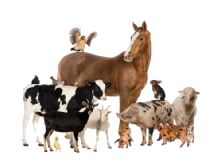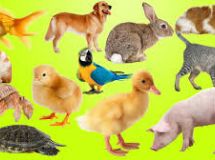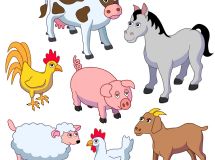So what is a working or active dog? Is that a silly question? Well, one UK pet food company advertised on their website that all dogs are working dogs - even the couch potato pooch who barks when someone comes to the door is working as a guard dog.
However, this was mainly to justify the labelling of their food as a 'working dog food' which they could sell as VAT free for all dogs, be they 'resting' or 'active'.
Another problem is that the majority of research on performance dog nutrition has been conducted on endurance sled dogs, the nutrition of which bears little resemblance to that of the average working or hunting dog which takes part in fly ball, activity trials or just long walks and ball chasing.
Research on this subject has mainly been conducted by the larger pet food companies such as Purina and Iams, and gives us useful information as to how we should approach the feeding of active dogs.
I have given links to relevant sites at the end of this article should you wish to read the whole papers, but summarise the information below for those who maybe don't have a spare hour or two to digest the research! So for the purposes of this article I'm going to concentrate on what the experts call the 'intermediate athlete' which is a dog not involved in endurance sled racing, but maybe goes hunting, regularly trains for flyball or activity sports, or is taken daily for long runs in the countryside.
Working sheep dogs rarely come into this category as with some exceptions they only work flat out for a short period of time, and not necessarily daily.
Basic requirements for a diet containing balanced quantities of protein, fats and carbohydrates are the same for all dogs, whether they are active or not - it's the percentages that maybe need to change.
Most commercial working dog foods contain more protein, fat and carbohydrate than a normal adult diet, but product comparisons are not easy because of the variation between diets, both on protein and fat percentages (a quick survey threw up products with 10 - 20% fat, and 22 - 28% protein) Popular Misconceptions about feeding active dogs 1) I need a high protein diet for an active dog.
Not really.
Traditionally it has been assumed that there is a high protein requirement for human and canine athletes, and there is evidence that requirements do rise for increased performance, but other constituents also need to be raised so that protein is not used preferentially for energy, but rather for tissue building and replacement.
Very low protein levels increase the chance of injury.
So a moderate increase in protein (over the normal maintenance diet) is recommended.
2) High carb diets are the way to go Human athletes load up the carbs during training, eating lots of pasta, but dogs are not humans (you may have noticed!) and their requirements for carbohydrates are not so high.
So, if carbohydrates help people, why don't they help canine athletes? The reasons are complex and involve differences in gait, cardiovascular physiology and energy metabolism.
Dogs and humans just have differences.
In fact, in the early seventies, it was observed that sled dogs fed high-carbohydrate rations actually had poor endurance and even a stiff gait while racing.
In fact, it is fat that is the main requirement for good performance.
Dogs fed on a higher fat diet are better able to utilize oxygen, and this has been demonstrated by detecting an increased number of mitochondria in the muscle cells of dogs fed a high fat ration.
These are the furnaces of the cell.
SOME CONSIDERATIONS BODY CONDITION - Because the feeding of active dogs is not a precise science (there are so many levels of activity) you should always judge the success of a feeding regime against the general body condition chart.
This is so important, and such an easy way of checking that things are going well.
Using a feed which supplies more energy than the dog needs will lead to excess weight gain, which will compromise performance and can result in obesity, which is thought to be a predisposing factor in osteoarthritis.
(See body condition chart for reference) If your dog is only exercising infrequently then a maintenance diet might be appropriate, and certainly if the activity levels are seasonal then this should be the diet during resting periods.
DIGESTIBILITY - The digestibility of a diet is paramount for active dogs.
Arleigh Reynolds, DVM, PhD, DACVN in a paper for Purina says 'Intermediate canine athletes can vary in energy requirements depending on the sport in which they are participating, the environmental conditions and the frequency of exercise.
However, diet digestibility should be at least 80% in order for the dogs to effectively metabolise and use the nutrients supplied by the food without excess faecal bulk and for them to be able to ingest enough calories to meet energy needs while in training and competing in athletic events.
'The more energy dense the food is, the less voluminous the stool, which is advantageous in exercising dogs.
Kronfeld et al estimated that racing sled dogs with full colons were handicapped equivalent to a jockey and racehorse being assessed a 20 lb handicap' How do we know whether a food is highly digestible or not? Check the ingredients.
Rice is more digestible than wheat or Soya, fish and chicken are more digestible than beef.
Sticking with named types of meat rather than a generic 'meat and animal derivative' based diet means that there's less chance of variability in digestibility.
Some foods also use bulking agents such as sugar beet pulp, and you may want to consider whether or not this is desirable.
HYDRATION - An adequate supply of water is important during intense activity.
Around 60% of heat dissipated by a dog during exercise is through water evaporation, and because dogs generally do not lose electrolytes by sweating as humans do, they don't benefit from electrolyte replacement fluids.
WHEN TO FEED - Exercise affects gastrointestinal transit time and therefore can change nutrient digestion and absorption.
It can also increase the heat loading on the dog's body.
Arleigh Reynolds recommends that intensely exercising dogs be fed approximately 24 hours before an intense exercise bout to help alleviate problems associated with a full colon.
If the sporting activity in which they are participating is a multiple day event, then dogs should be fed as soon after exercise as possible so that they have the maximum amount of time to digest the meal before the next exercise bout.
WHAT TO FEED - Using a complete commercial diet makes life a lot simpler in calculating percentages.
Home cooking or raw feeding are perfectly possible but may cause problems because they are less likely to offer the energy dense diet that is recommended.
For the purposes of this article, and based upon the research undertaken by Iams and Purina, the following recommendations would seem to be appropriate.
a) A highly digestible food which is nutrient dense (look for high quality ingredients) so as to allow for adequate supply of energy in a small volume of food (look at the feeding guide for the food on the bag) b) Moderately high protein, of good quality and higher fat content (when compared to normal maintenance diet) c) Good palatability (the dog must like the diet!) d) An appropriate balance of micro-nutrients (vitamins, antioxidants, minerals) As the owner of a gundog who runs between 5-8 miles a day, I have found that a highly digestible maintenance diet with moderate levels of fat and protein (currently James Wellbeloved Fish & Rice at 10% fat and 20% protein) is most appropriate, with higher fat diets only leading to weight gain.
Likewise a lighter diet with only 8% fat caused weight loss problems.
References: Conditioning the Performance Dog: Martin Coffman, DVM, Research and Development Division, The Iams Company, Lewisburg, Ohio, USA Performance dog feeding: Arleigh Reynolds, DVM, PhD, DACVN, Jill Cline, PhD Purina
However, this was mainly to justify the labelling of their food as a 'working dog food' which they could sell as VAT free for all dogs, be they 'resting' or 'active'.
Another problem is that the majority of research on performance dog nutrition has been conducted on endurance sled dogs, the nutrition of which bears little resemblance to that of the average working or hunting dog which takes part in fly ball, activity trials or just long walks and ball chasing.
Research on this subject has mainly been conducted by the larger pet food companies such as Purina and Iams, and gives us useful information as to how we should approach the feeding of active dogs.
I have given links to relevant sites at the end of this article should you wish to read the whole papers, but summarise the information below for those who maybe don't have a spare hour or two to digest the research! So for the purposes of this article I'm going to concentrate on what the experts call the 'intermediate athlete' which is a dog not involved in endurance sled racing, but maybe goes hunting, regularly trains for flyball or activity sports, or is taken daily for long runs in the countryside.
Working sheep dogs rarely come into this category as with some exceptions they only work flat out for a short period of time, and not necessarily daily.
Basic requirements for a diet containing balanced quantities of protein, fats and carbohydrates are the same for all dogs, whether they are active or not - it's the percentages that maybe need to change.
Most commercial working dog foods contain more protein, fat and carbohydrate than a normal adult diet, but product comparisons are not easy because of the variation between diets, both on protein and fat percentages (a quick survey threw up products with 10 - 20% fat, and 22 - 28% protein) Popular Misconceptions about feeding active dogs 1) I need a high protein diet for an active dog.
Not really.
Traditionally it has been assumed that there is a high protein requirement for human and canine athletes, and there is evidence that requirements do rise for increased performance, but other constituents also need to be raised so that protein is not used preferentially for energy, but rather for tissue building and replacement.
Very low protein levels increase the chance of injury.
So a moderate increase in protein (over the normal maintenance diet) is recommended.
2) High carb diets are the way to go Human athletes load up the carbs during training, eating lots of pasta, but dogs are not humans (you may have noticed!) and their requirements for carbohydrates are not so high.
So, if carbohydrates help people, why don't they help canine athletes? The reasons are complex and involve differences in gait, cardiovascular physiology and energy metabolism.
Dogs and humans just have differences.
In fact, in the early seventies, it was observed that sled dogs fed high-carbohydrate rations actually had poor endurance and even a stiff gait while racing.
In fact, it is fat that is the main requirement for good performance.
Dogs fed on a higher fat diet are better able to utilize oxygen, and this has been demonstrated by detecting an increased number of mitochondria in the muscle cells of dogs fed a high fat ration.
These are the furnaces of the cell.
SOME CONSIDERATIONS BODY CONDITION - Because the feeding of active dogs is not a precise science (there are so many levels of activity) you should always judge the success of a feeding regime against the general body condition chart.
This is so important, and such an easy way of checking that things are going well.
Using a feed which supplies more energy than the dog needs will lead to excess weight gain, which will compromise performance and can result in obesity, which is thought to be a predisposing factor in osteoarthritis.
(See body condition chart for reference) If your dog is only exercising infrequently then a maintenance diet might be appropriate, and certainly if the activity levels are seasonal then this should be the diet during resting periods.
DIGESTIBILITY - The digestibility of a diet is paramount for active dogs.
Arleigh Reynolds, DVM, PhD, DACVN in a paper for Purina says 'Intermediate canine athletes can vary in energy requirements depending on the sport in which they are participating, the environmental conditions and the frequency of exercise.
However, diet digestibility should be at least 80% in order for the dogs to effectively metabolise and use the nutrients supplied by the food without excess faecal bulk and for them to be able to ingest enough calories to meet energy needs while in training and competing in athletic events.
'The more energy dense the food is, the less voluminous the stool, which is advantageous in exercising dogs.
Kronfeld et al estimated that racing sled dogs with full colons were handicapped equivalent to a jockey and racehorse being assessed a 20 lb handicap' How do we know whether a food is highly digestible or not? Check the ingredients.
Rice is more digestible than wheat or Soya, fish and chicken are more digestible than beef.
Sticking with named types of meat rather than a generic 'meat and animal derivative' based diet means that there's less chance of variability in digestibility.
Some foods also use bulking agents such as sugar beet pulp, and you may want to consider whether or not this is desirable.
HYDRATION - An adequate supply of water is important during intense activity.
Around 60% of heat dissipated by a dog during exercise is through water evaporation, and because dogs generally do not lose electrolytes by sweating as humans do, they don't benefit from electrolyte replacement fluids.
WHEN TO FEED - Exercise affects gastrointestinal transit time and therefore can change nutrient digestion and absorption.
It can also increase the heat loading on the dog's body.
Arleigh Reynolds recommends that intensely exercising dogs be fed approximately 24 hours before an intense exercise bout to help alleviate problems associated with a full colon.
If the sporting activity in which they are participating is a multiple day event, then dogs should be fed as soon after exercise as possible so that they have the maximum amount of time to digest the meal before the next exercise bout.
WHAT TO FEED - Using a complete commercial diet makes life a lot simpler in calculating percentages.
Home cooking or raw feeding are perfectly possible but may cause problems because they are less likely to offer the energy dense diet that is recommended.
For the purposes of this article, and based upon the research undertaken by Iams and Purina, the following recommendations would seem to be appropriate.
a) A highly digestible food which is nutrient dense (look for high quality ingredients) so as to allow for adequate supply of energy in a small volume of food (look at the feeding guide for the food on the bag) b) Moderately high protein, of good quality and higher fat content (when compared to normal maintenance diet) c) Good palatability (the dog must like the diet!) d) An appropriate balance of micro-nutrients (vitamins, antioxidants, minerals) As the owner of a gundog who runs between 5-8 miles a day, I have found that a highly digestible maintenance diet with moderate levels of fat and protein (currently James Wellbeloved Fish & Rice at 10% fat and 20% protein) is most appropriate, with higher fat diets only leading to weight gain.
Likewise a lighter diet with only 8% fat caused weight loss problems.
References: Conditioning the Performance Dog: Martin Coffman, DVM, Research and Development Division, The Iams Company, Lewisburg, Ohio, USA Performance dog feeding: Arleigh Reynolds, DVM, PhD, DACVN, Jill Cline, PhD Purina
SHARE




































